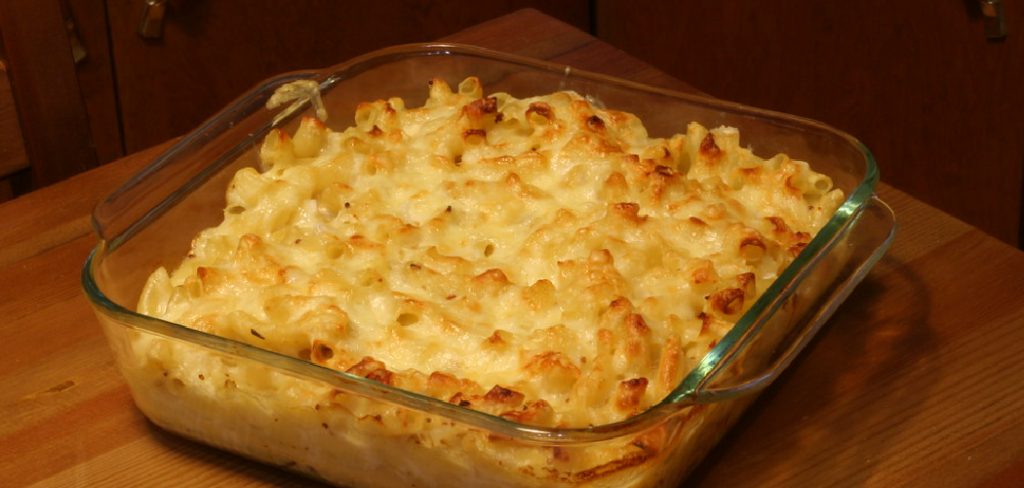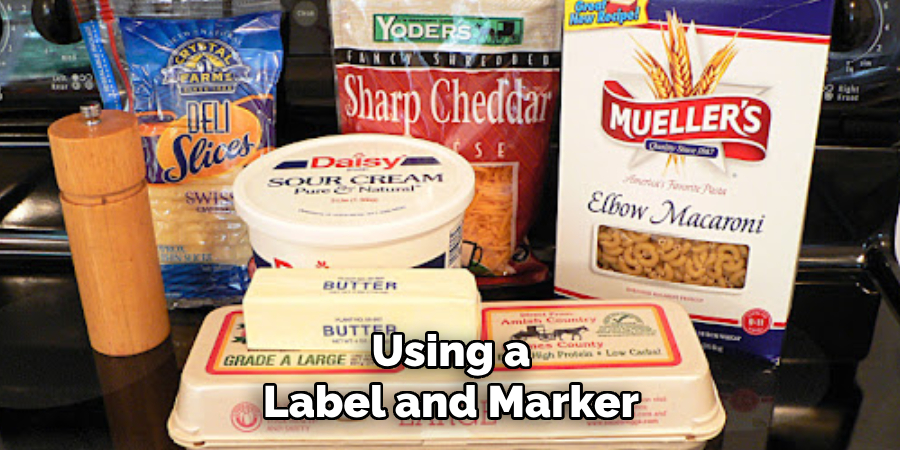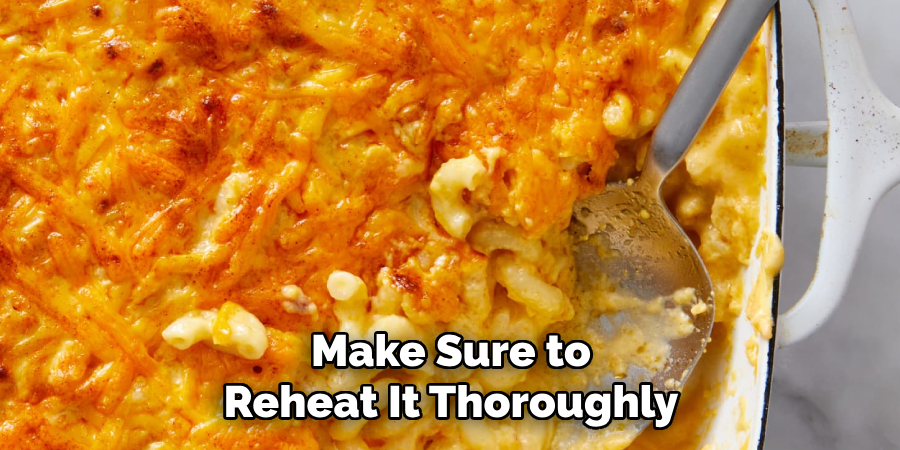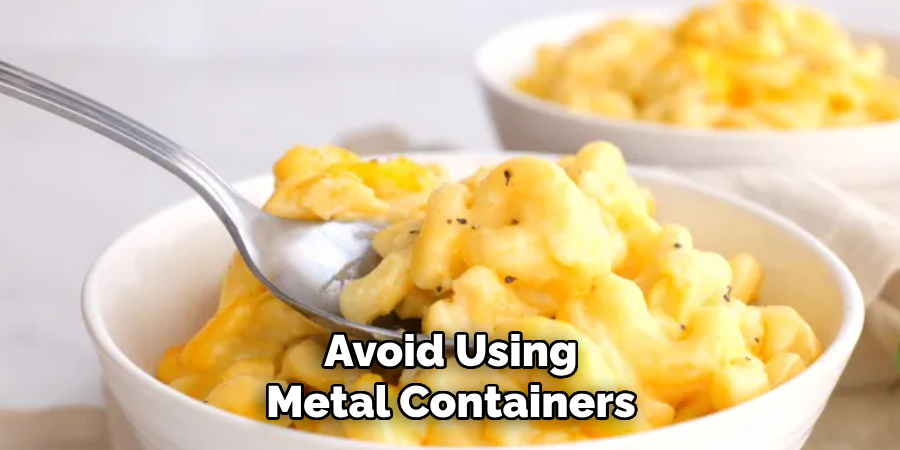Baked mac and cheese is a comforting and delicious dish that’s perfect for family meals or gatherings. However, storing leftovers properly is essential to maintain their flavor and texture. Whether you have a small portion or an entire dish to save, knowing the best storage methods can help extend its freshness and make reheating a breeze.
In this blog post on how to store baked mac and cheese, we’ll cover different ways to keep your leftovers fresh and tasty.

Why is Proper Storage Important?
As with most dishes, baked mac and cheese can spoil if not stored correctly. It’s a dairy-based dish that contains ingredients such as cheese, milk, and butter, which are prone to bacterial growth if left at room temperature for too long.
Furthermore, improper storage can also affect the texture and taste of the dish. If it’s not stored in an airtight container or reheated properly, the mac and cheese may become dry, rubbery, or even develop an unpleasant smell.
By following the right storage methods, you can prevent food waste and enjoy your baked mac and cheese for longer.
Needed Materials
Airtight Container or Aluminum Foil
An airtight container is the best option for storing baked mac and cheese. It prevents air and moisture from entering, keeping the dish fresh and moist. Aluminum foil can also be used to cover the dish if you don’t have an airtight container.
Label and Marker
Labeling your leftovers with the date can help you keep track of when they were made, making it easier to know how long they have been in the fridge.
Freezer Bags or Containers (Optional)
If you plan on freezing your leftover mac and cheese, freezer bags or containers are a great alternative to aluminum foil. They take up less space and can be easily stacked in the freezer.
8 Step-by-step Guidelines on How to Store Baked Mac and Cheese
Step 1: Allow the Dish to Cool

Before storing baked mac and cheese, it’s important to allow the dish to cool to room temperature. Placing hot food directly into the refrigerator or freezer can raise the temperature inside the appliance, potentially affecting other stored items and leading to uneven cooling.
Give the dish around 20-30 minutes to cool down, but make sure not to leave it out for more than two hours to avoid bacterial growth.
Step 2: Portion the Leftovers
Dividing the dish into smaller portions can help with easier and faster reheating. It also prevents unnecessary wastage if you only want to reheat a small serving at a time.
You can use ramekins or small containers for individual servings or divide the mac and cheese into sections in one large container using foil dividers.
Step 3: Transfer the Mac and Cheese Into an Airtight Container
If you’re using an airtight container, make sure to leave some space at the top for expansion during freezing. Fill the container with mac and cheese and close the lid tightly.
If using aluminum foil, cover the dish completely, making sure there are no gaps or openings for air to enter.
Step 4: Label the Container

Using a label and marker, write the date the baked mac and cheese was prepared and stored. This step is essential for tracking its freshness and ensuring it is consumed within a safe timeframe. Proper labeling is particularly helpful if you are storing multiple dishes in the fridge or freezer, as it prevents confusion and helps you prioritize older leftovers before they go bad.
Secure the label to the container or write directly on the freezer bag if applicable.
Step 5: Place in the Refrigerator or Freezer
If storing in the refrigerator, place the container on a shelf rather than on the door. The temperature is more consistent and cooler towards the back of the fridge, making it an ideal spot for perishable foods like mac and cheese.
For freezing, make sure to place the dish in a flat position to prevent any spills or leaks. If using freezer bags, lay them flat in the freezer until they are frozen solid before stacking them upright.
Step 6: Consume Within Recommended Timeframes
Stored properly, baked mac and cheese can last for up to five days in the refrigerator and three months in the freezer. However, it is best to consume leftovers within three days, as the quality may deteriorate after that. If freezing, try to use up the leftover mac and cheese within a month for optimum taste and texture.
The USDA recommends following the “first in, first out” rule when it comes to frozen foods, meaning use older items before newer ones for best quality and safety.
Step 7: Reheat Thoroughly

When ready to eat your stored baked mac and cheese, make sure to reheat it thoroughly. The dish should reach an internal temperature of 165°F (74°C) to kill any potential bacteria.
If reheating from the fridge, transfer the desired portion into a microwave-safe bowl and cover with a damp paper towel. Heat in 30-second increments, stirring in between until heated through. If using the oven, preheat it to 350°F (175°C), place the mac and cheese in an oven-safe dish, cover with foil, and heat for 15-20 minutes.
For frozen mac and cheese, thaw it overnight in the refrigerator before reheating it using the same methods mentioned above.
Step 8: Enjoy Your Delicious Baked Mac and Cheese!

Now that you know how to properly store baked mac and cheese, you can enjoy it without worrying about food safety or quality. Whether you’re saving leftovers from a big family meal or making a batch ahead of time for easy weeknight dinners, these storage tips will ensure that your mac and cheese stays fresh and delicious every time! So go ahead and indulge in this comforting dish whenever the craving strikes.
And don’t be afraid to get creative with your leftovers – use them as a topping for pizza, mix them into a casserole, or turn them into mac and cheese bites. The possibilities are endless! Happy cooking and storing!
Following these guidelines will not only help you save food and money but also contribute to reducing food waste. By properly storing your baked mac and cheese, you can minimize the amount of food that goes to waste in your household. And don’t forget – always trust your senses when it comes to determining if a dish is safe to eat. If it looks or smells off, it’s better to err on the side of caution and discard it. With these tips on how to store baked mac and cheese, you can confidently store your baked mac and cheese and enjoy it to the fullest potential!
Additional Tips

- Avoid using metal containers or utensils when storing and reheating mac and cheese, as it can cause a metallic taste. Opt for glass or microwave-safe plastic containers instead.
- If you plan on freezing individual servings of mac and cheese, wrap each portion in plastic wrap before placing them in the freezer bag to prevent freezer burn.
- Don’t forget to label any additional ingredients or toppings that were added to your baked mac and cheese, especially if they have storage requirements different from the dish itself.
- It’s always better to store leftovers in smaller portions rather than one large container, as it reduces the risk of bacterial growth and makes reheating more convenient.
- When reheating in the oven, sprinkle a little bit of water or milk over the mac and cheese before covering it with foil. This will help prevent the dish from drying out.
- If you have any leftover mac and cheese that you don’t plan on consuming within three days, consider freezing it right away for longer storage.
- You can also use these guidelines when storing other types of baked pasta dishes like lasagna or baked ziti.
- Consider adding additional ingredients such as vegetables, protein, or different types of cheese to your leftovers to switch things up and prevent food boredom.
- Always trust your senses – if something looks, smells, or tastes off, discard it immediately. It’s better to be safe than sorry!
Frequently Asked Questions
Q: Can You Freeze Baked Mac and Cheese?
A: Yes, baked mac and cheese can be frozen for up to three months. However, it is best to consume within one month for optimum taste and texture.
Q: Can You Reheat Frozen Baked Mac and Cheese?
A: Yes, you can reheat frozen baked mac and cheese by thawing it overnight in the refrigerator or reheating it directly from frozen using the microwave or oven. Just make sure to reach an internal temperature of 165°F (74°C) before consuming.
Q: How Long Does Baked Mac and Cheese Last in the Fridge?
A: Baked mac and cheese can last up to five days in the fridge when stored properly. It is best to consume within three days for optimal freshness and quality.
Q: Can You Reheat Baked Mac and Cheese in the Microwave?
A: Yes, you can reheat baked mac and cheese in the microwave by transferring it to a microwave-safe dish, covering it with a damp paper towel, and heating it in 30-second increments until heated through. Stir in between for even heating.
Q: Can You Refreeze Leftover Baked Mac and Cheese?
A: It is not recommended to refreeze leftover baked mac and cheese as it can affect its taste and texture. It is best to consume within one month after freezing for optimal freshness. So make sure to portion your leftovers properly when storing them! Keep enjoying that delicious mac and cheese! Keep enjoying that delicious mac and cheese!
Conclusion
Storing, freezing, and reheating baked mac and cheese properly ensures that this beloved comfort food stays fresh, delicious, and safe to eat. By following the steps on how to store baked mac and cheese outlined above, you can extend the life of your leftovers, save time on meal prep, and reduce food waste. With the ability to enjoy baked mac and cheese for days or even weeks after its initial preparation, you’ll always have a warm and satisfying meal ready when you need it.
Whether you’re whipping up a quick dinner, indulging in a cozy snack, or getting creative with leftovers, the tips in this guide will help you make the most of every bite. Happy cooking!
Professional Focus
Angela Ervin, a former interior designer turned blogger, specializes in kitchen design and renovations. Through her website, she blends her passion for cooking with design expertise, sharing practical and creative ideas. Known for balancing functionality and beauty, Angela’s insightful content has made her a trusted voice in home design and lifestyle.
About the Author
Angela Ervin, an experienced interior designer and blogger, combines her passion for kitchen renovations with storytelling. Living in Petersburg with her family, she enjoys cooking and testing her projects firsthand. Known for her humor and relatable style, Angela shares creative, functional design insights through her content, making her a trusted voice in home design.
Education History
University: Virginia Commonwealth University
Degree: Bachelor of Fine Arts (BFA) in Interior Design
- Angela’s education at VCU focused on mastering core interior design principles, including spatial planning, color theory, materials selection, and sustainable design practices.
- She gained hands-on experience through studio projects and collaborative design exercises, which honed her ability to create functional and aesthetically pleasing environments.
- Her coursework also emphasized problem-solving and practical applications of design, preparing her for real-world projects like her self-directed kitchen renovations.
- The program’s strong foundation in both technical skills and creative expression shaped Angela’s ability to seamlessly integrate form and function in her work.


